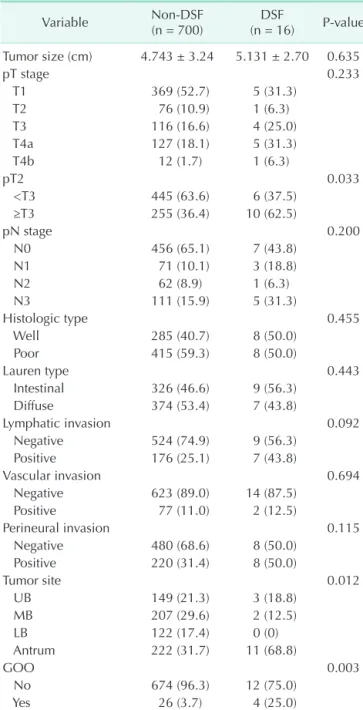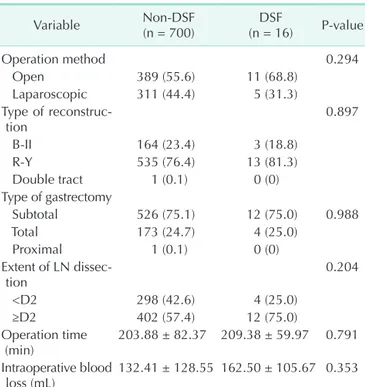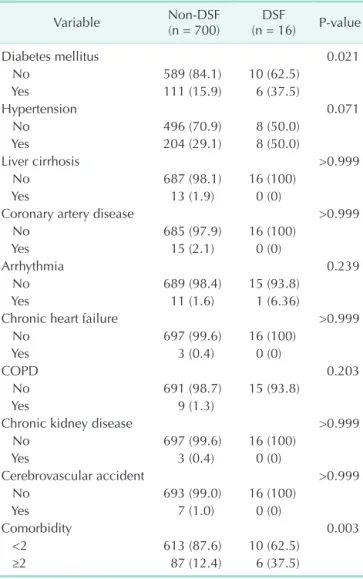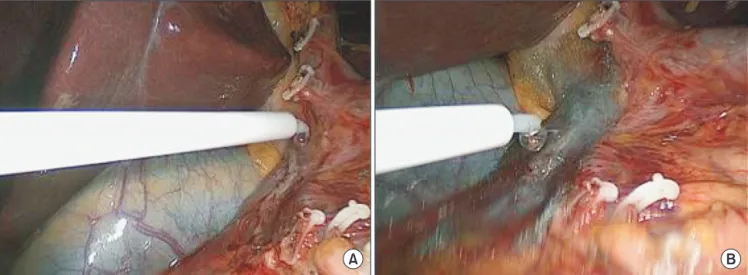http://dx.doi.org/10.4174/astr.2016.90.3.157 Annals of Surgical Treatment and Research
Duodenal stump fistula after gastrectomy for gastric cancer: risk factors, prevention, and management
Hyun-June Paik*, Si-Hak Lee*, Chang-In Choi, Dae-Hwan Kim, Tae-Yong Jeon1, Dong-Heon Kim1, Ung-Bae Jeon2, Cheol-Woong Choi3, Sun-Hwi Hwang
Department of Surgery, Pusan National University Yangsan Hospital, Yangsan, 1Department of Surgery, Pusan National University School of Medicine, Busan, Departments of 2Radiology and 3Internal Medicine, Pusan National University Yangsan Hospital, Yangsan, Korea
INTRODUCTION
A duodenal stump fistula (DSF) forming after a gastrectomy for gastric cancer is a life-threatening complication. Even though the overall incidence is low (1.8%–3%), the DSF-related mortality rate is reported to be 7% to 67% [1-3]. There are many DSF-related complications leading to longer hospitalization times, such as intra-abdominal abscesses, wound infections, diffuse peritonitis, sepsis, malnutrition, pancreatitis, abdominal bleeding, and pneumonia [1].
DSF is thought to be caused by many factors such as
inadequate closure of the duodenal stump, devascularization, cancer involvement or resection, an inflamed duodenal wall, local hematoma, incorrect drain position and postoperative distension of the duodenum [4]. Orsenigo et al. [5] first reported the risk factors associated with postoperative DSF to be heart disease, liver cirrhosis, intraoperative blood loss (>300 mL) and the absence of manual reinforcement. However, that analysis focused on intraoperative factors. The aim of the present study was to analyze the risk factors for DSF that could be revealed during the preoperative evaluation for obtaining informed consent before surgery. By identifying them, we should be Purpose: A duodenal stump fistula is one of the most severe complications after gastrectomy for gastric cancer. We aimed to analyze the risk factors for this problem, and to identify the methods used for its prevention and management.
Methods: We retrospectively reviewed the clinical data of 716 consecutive patients who underwent curative gastrectomy with a duodenal stump for gastric cancer between 2008 and 2013.
Results: A duodenal stump fistula occurred in 16 patients (2.2%) and there were 2 deaths in this group. Univariate analysis revealed age >60 years (odds ratio [OR], 3.09; 95% confidence interval [CI], 0.99–9.66), multiple comorbidities (OR, 4.23; 95% CI, 1.50–11.92), clinical T stage (OR, 2.91; 95% CI, 1.045-8.10), and gastric outlet obstruction (OR, 8.64; 95%
CI, 2.61–28.61) to be significant factors for developing a duodenal stump fistula. Multivariate analysis identified multiple comorbidities (OR, 3.92; 95% CI, 1.30–11.80) and gastric outlet obstruction (OR, 5.62; 95% CI, 1.45–21.71) as predictors of this complication.
Conclusion: Multiple comorbidities and gastric outlet obstruction were the main risk factors for a duodenal stump fistula.
Therefore, preventive methods and aggressive management should be applied for patients at high risk.
[Ann Surg Treat Res 2016;90(3):157-163]
Key Words: Intestinal fistula, Gastric neoplasms, Gastrectomy, Complication
Reviewed January February March April May June July August September October November December
Received October 1, 2015, Revised November 5, 2015, Accepted November 30, 2015
Corresponding Author: Sun-Hwi Hwang
Department of Surgery, Pusan National University Yangsan Hospital, 20 Geumo-ro, Mulgeum-eup, Yangsan 50612, Korea
Tel: +82-55-360-2124, Fax: +82-55-360-2154 E-mail: hwangsh@pusan.ac.kr
*Hyun-June Paik and Si-Hak Lee contributed equally to this study as co- first authors.
Copyright ⓒ 2016, the Korean Surgical Society
cc Annals of Surgical Treatment and Research is an Open Access Journal. All articles are distributed under the terms of the Creative Commons Attribution Non- Commercial License (http://creativecommons.org/licenses/by-nc/4.0/) which permits unrestricted non-commercial use, distribution, and reproduction in any medium, provided the original work is properly cited.
able to pay more attention to patients who are in high-risk groups during the surgery and postoperative management. The risk factors for DSF after gastrectomy for gastric cancer were analyzed retrospectively, and we also describe the methods used for prevention and management of DSF in our institution.
METHODS
The records of 1,018 consecutive patients who underwent cu- rative gastrectomy from November 2008 to December 2013 were reviewed retrospectively. All of the patients had gastric cancer.
Among them, 716 had a duodenal stump after gastrectomy.
The methods used for intestinal reconstruction were Billroth II gastrojejunostomy (B-II) with jejunojejunostomy (Braun’s anastomosis) or Roux-en Y (R-Y) gastrojejunostomy for subtotal gastrectomy and R-Y esophagojejunostomy for total gastrectomy.
DSF was diagnosed by the presence of duodenal fluid in the surgical drainage and confirmed by a CT scan when needed.
The location of any tumor in the stomach was classified into 4 regions: antrum, stomach angle to lower body, mid body to high body, and cardia/fundus [6].
Surgical procedures
Duodenal transection was performed using a linear stapler (DST Series TA 60 mm, Covidien, Boulder, CO, USA) in cases involving open gastrectomy. In laparoscopic cases, a laparoscopic linear stapler (ECHELON FLEX ENDOPATH, Ethicon Endo-Surgery, Cincinnati, OH, USA) was used for duodenal transection. For surgery involving B-II with Braun’s anastomosis, a side-to-side gastrojejunostomy was made approximately 40 cm distal to the ligament of Treitz via the antecolic pathway, and Braun’s anastomosis was performed about 25 cm distal to the gastrojejunostomy. In patients who
underwent an R-Y anastomosis, the jejunum was brought through the antecolic route after its division. The distance between gastrojejunostomy and the jejunojejunal anastomosis was about 25 cm, which is considered adequate for preventing bile reflux, with respect to intestinal limb length and Roux stasis or kinking.
To prevent DSF during surgery, we used an absorbable reinforcement felt (Neoveil, Gunze Limited, Shenzhen, China)
Table 1. Demographic characteristics after gastrectomy for gastric cancer
Variable NonDSF
(n = 700) DSF
(n = 16) Pvalue
Age (yr) 0.046
<60 355 (50.7) 4 (25.0)
≥60 345 (49.3) 12 (75.0)
Sex 0.287
Male 456 (65.1) 13 (81.3)
Female 244 (34.9) 3 (18.8)
Body mass index (kg/m2) 23.6 ± 3.56 24.07 ± 2.69 0.602
ASA score 0.026
<2 673 (96.1) 13 (81.3)
≥2 27 (3.9) 3 (18.8)
Values are presented as number (%) or mean ± standard devia
tion.
DSF, duodenal stump fistula; ASA, American Society of Anesthe
siologists.
Table 2. Oncologic characteristics after gastrectomy for gastric cancer
Variable NonDSF
(n = 700) DSF
(n = 16) Pvalue Tumor size (cm) 4.743 ± 3.24 5.131 ± 2.70 0.635
pT stage 0.233
T1 369 (52.7) 5 (31.3)
T2 76 (10.9) 1 (6.3)
T3 116 (16.6) 4 (25.0)
T4a 127 (18.1) 5 (31.3)
T4b 12 (1.7) 1 (6.3)
pT2 0.033
<T3 445 (63.6) 6 (37.5)
≥T3 255 (36.4) 10 (62.5)
pN stage 0.200
N0 456 (65.1) 7 (43.8)
N1 71 (10.1) 3 (18.8)
N2 62 (8.9) 1 (6.3)
N3 111 (15.9) 5 (31.3)
Histologic type 0.455
Well 285 (40.7) 8 (50.0)
Poor 415 (59.3) 8 (50.0)
Lauren type 0.443
Intestinal 326 (46.6) 9 (56.3)
Diffuse 374 (53.4) 7 (43.8)
Lymphatic invasion 0.092
Negative 524 (74.9) 9 (56.3)
Positive 176 (25.1) 7 (43.8)
Vascular invasion 0.694
Negative 623 (89.0) 14 (87.5)
Positive 77 (11.0) 2 (12.5)
Perineural invasion 0.115
Negative 480 (68.6) 8 (50.0)
Positive 220 (31.4) 8 (50.0)
Tumor site 0.012
UB 149 (21.3) 3 (18.8)
MB 207 (29.6) 2 (12.5)
LB 122 (17.4) 0 (0)
Antrum 222 (31.7) 11 (68.8)
GOO 0.003
No 674 (96.3) 12 (75.0)
Yes 26 (3.7) 4 (25.0)
Values are presented as mean ± standard deviation or number (%).
DSF, duodenal stump fistula; UB, upperbody; MB, midbody; LB, lowbody; GOO, gastric outlet obstruction.
and a fibrin sealant (Tisseel, Baxter AG, Wien, Austria) on the duodenal stump.
Statistical analysis
All data were analyzed using IBM SPSS Statistics ver. 21.0 (IBM Co., Armonk, NY, USA). Categorical outcomes were analyzed using the chi-square test and Fisher exact test. Mean differences between the two groups (with and without DSF) were analyzed using Student t-test. Independent risk factors associated with DSF after gastrectomy were analyzed using logistic regression analysis. The odds ratios (ORs) were estimated with 95% confidence intervals (CIs). Differences were considered statistically significant at P < 0.05.
RESULTS
Demographic characteristics
A DSF after gastrectomy for gastric cancer was found in 16 of the 716 patients (2.2%). The demographic characteristics of patients with and without DSF are summarized in Table 1. The 2 groups were similar with regard to age, sex, and body mass index. However, there was a statistically significant difference in the American Society of Anesthesiologists (ASA) physical status score between the 2 groups (P = 0.026).
Oncological characteristics
Table 2 shows the oncological characteristics of patients with and without DSF. The complication occurred more frequently in patients with tumors graded more than pT2 (P = 0.033). There was a significant difference in the incidence of DSF in patients with tumors located at the antrum compared with those with tumors located at the stomach angle to low body (P = 0.012).
Patients who had a gastric outlet obstruction (GOO) before gastrectomy also had a higher occurrence rate (P = 0.003).
Surgical characteristics
The surgical characteristics of patients in the 2 groups are shown in Table 3. The surgical method, type of reconstruction, type of gastrectomy, extent of lymph node dissection, operation time, and intraoperative blood loss were compared. However, there were no statistically significant differences between the 2 groups.
Comorbidity factors
Univariate analysis was used to evaluate comorbidity factors in the 2 groups. The comorbidity factors used in our study were diabetes mellitus (DM), hypertension, liver cirrhosis, coronary artery disease, arrhythmia, chronic heart failure, chronic obstructive pulmonary disease, chronic kidney disease, and cerebrovascular accident. Patients under medication or observation after diagnosis with these comorbidities were
all included in our analysis. Only DM showed a statistically significant difference between the two groups (P = 0.021).
In addition, patients with multiple comorbidities had a significantly higher rate of DSF (P = 0.003). The results are summarized in Table 4.
Multivariate analysis of risk factors
Univariate analysis showed that age, ASA score, pathology T stage, tumor location, GOO, DM, and multiple comorbidities were significant factors for developing a DSF. In the multivariate analysis, multiple comorbidities (OR, 3.92; 95% CI, 1.30–11.80) and GOO (OR, 5.62; 95% CI, 1.45–21.71) were the risk factors for DSF (Table 5). Tumor location was excluded from this analysis because GOO only occurred in tumors located at the antrum.
Clinicopathology results
The clinicopathology results of patients who developed DSF are shown in Table 6. DSF occurred in 16 patients (2.2%) and there were 2 deaths in this subgroup. The mean interval of DSF after operation was 6.6 days. Both of the deaths were associated with complications from DSF [1]. One patient died from sepsis and bleeding and the other patient died from pneumonia.
Three patients were submitted to a reoperation at postoperative days 1 or 2. Primary repair of the duodenal stump with Table 3. Surgical characteristics after gastrectomy for gastric cancer
Variable NonDSF
(n = 700) DSF
(n = 16) Pvalue
Operation method 0.294
Open 389 (55.6) 11 (68.8)
Laparoscopic 311 (44.4) 5 (31.3) Type of reconstruc
tion 0.897
BII 164 (23.4) 3 (18.8)
RY 535 (76.4) 13 (81.3)
Double tract 1 (0.1) 0 (0)
Type of gastrectomy
Subtotal 526 (75.1) 12 (75.0) 0.988
Total 173 (24.7) 4 (25.0)
Proximal 1 (0.1) 0 (0)
Extent of LN dissec
tion 0.204
<D2 298 (42.6) 4 (25.0)
≥D2 402 (57.4) 12 (75.0)
Operation time
(min) 203.88 ± 82.37 209.38 ± 59.97 0.791 Intraoperative blood
loss (mL) 132.41 ± 128.55 162.50 ± 105.67 0.353 DSF, duodenal stump fistula; BII, Billroth II; RY, RouxenY; LN, lymph node.
Values are presented as number (%) or mean ± standard devia
tion.
choledochostomy and feeding jejunostomy was performed for these patients. Six patients were managed by ultrasound-guided PTBD. Seven other patients recovered with supportive care such as percutaneous drainage, TPN, and octreotide treatment. The
mean duration of hospital stay after surgery was 29.4 days.
DISCUSSION
DSF after gastrectomy for gastric cancer is a rare complication with an incidence of 1.8%–3% [1-3]. However, once DSF occurs it is a life-threatening complication with a mortality rate of 7%–67% [1-3]. In our study, the incidence of DSF was 2.2% and the mortality rate was 12.5% in those patients. One patient died from sepsis and bleeding and the other patient died from pneumonia following DSF. These are common complications from DSF [1].
Various factors have been reported to cause DSF [4].
Orsenigo et al. [5] first reported the risk factors associated with postoperative DSF to be heart disease, liver cirrhosis, intraoperative blood loss (>300 mL), and the absence of manual reinforcement. We found here that age, ASA score, pathology T stage, tumor location, GOO, DM, and multiple comorbidities were significant factors for DSF in the univariate analysis.
Multivariate analysis showed that GOO (OR, 5.62; 95% CI, 1.45–21.71) and multiple comorbidities (OR, 3.92; 95% CI, 1.30–
11.80) were the main risk factors for DSF after gastrectomy for gastric cancer. GOO occurs more frequently when gastric cancer locates in lower body, i.e., antrum. GOO can also cause inflammation at surrounding duodenal wall tissues. For these reasons, we secure more distal margin because of the danger that cancer can involve at resection line, and eventually more devascularization is required. This is why we think GOO could be a risk factor of DSF shown in our study [4,7].
GOO and multiple comorbidities are both easily revealed during preoperative evaluation for DSF (Fig. 1). Patients can be categorized into high-, and low-risk groups. High-risk patients are those who have GOO or multiple comorbidities. Low-risk patients are those who have no symptoms of obstruction and no more than a single comorbidity. This means that we can anticipate the risk before the operation and prepare to make an appropriate decision when DSF is doubtful. Moreover, the surgeon can pay more attention during the operation to prevent DSF from occurring.
Table 5. Risk factors for DSF after gastrectomy
Variable Univariate analysis Multivariate analysis
Pvalue 95% CI Odds ratio Pvalue 95% CI Odds ratio
Age, >60 yr 0.046 0.986–9.664 3.087 0.156 0.721–7.690 2.355
ASA score, >2 0.026 1.547–21.382 5.752
GOO 0.003 2.609–28.617 8.641 0.012 1.454–21.714 5.620
pT stage, >2 0.033 1.045–8.096 2.908 0.356 0.514–6.359 1.809
Diabetes mellitus 0.021 1.134–8.938 3.184
Multiple comorbidities 0.03 1.499–11.922 4.228 0.015 1.303–11.798 3.921
DSF, duodenal stump fistula; CI, confidence interval; ASA, American Society of Anesthesiologists; GOO, gastric outlet obstruction.
Table 4. Comorbidities after gastrectomy for gastric cancer
Variable NonDSF
(n = 700) DSF
(n = 16) Pvalue
Diabetes mellitus 0.021
No 589 (84.1) 10 (62.5)
Yes 111 (15.9) 6 (37.5)
Hypertension 0.071
No 496 (70.9) 8 (50.0)
Yes 204 (29.1) 8 (50.0)
Liver cirrhosis >0.999
No 687 (98.1) 16 (100)
Yes 13 (1.9) 0 (0)
Coronary artery disease >0.999
No 685 (97.9) 16 (100)
Yes 15 (2.1) 0 (0)
Arrhythmia 0.239
No 689 (98.4) 15 (93.8)
Yes 11 (1.6) 1 (6.36)
Chronic heart failure >0.999
No 697 (99.6) 16 (100)
Yes 3 (0.4) 0 (0)
COPD 0.203
No 691 (98.7) 15 (93.8)
Yes 9 (1.3)
Chronic kidney disease >0.999
No 697 (99.6) 16 (100)
Yes 3 (0.4) 0 (0)
Cerebrovascular accident >0.999
No 693 (99.0) 16 (100)
Yes 7 (1.0) 0 (0)
Comorbidity 0.003
<2 613 (87.6) 10 (62.5)
≥2 87 (12.4) 6 (37.5)
Values are presented as number (%).
DSF, duodenal stump fistula; COPD, chronic obstructive pulmonary disease.
To prevent DSF during surgery, we used an absorbable reinforcement felt (Neoveil, Gunze Limited, Shenzhen, China) [8-10] and a fibrin sealant (Tisseel, Baxter AG, Wien, Austria) [11,12] on the duodenal stump. First, we applied the fibrin sealant onto the duodenal stump and then sealed it with the absorbable reinforcement felt. The fibrin sealant was then reapplied to prevent DSF (Fig. 2).
Many methods have been proposed for the treatment of DSF such as surgical management, a percutaneous approach, enteral and/or TPN, and therapy with somatostatin and its analogues.
The usual surgical treatments are tube duodenostomy [13], repair with a rectus abdominis muscle flap [14], closure by Roux- en-Y duodenojejunostomy [15], and pancreaticoduodenectomy [16]. The usual methods of a percutaneous approach are abscess drainage, transhepatic biliary drainage [17,18], fistula closure using cyanoacrylate or prolamine [19], percutaneous transhepatic biliary drainage (PTBD), occlusion balloons [20] or Foley balloon catheter [21].
Three patients in our study underwent a reoperation involving primary repair of the duodenal stump using choledochostomy and feeding jejunostomy. Ultrasound-guided PTBD was performed for six of them (Fig. 3). The other seven patients recovered with supportive care. The mean duration of hospital stay after surgery was 29.4 days.
In conclusion, DSF is a life-threatening problem after gastrectomy for gastric cancer. Comorbidity and GOO were independent risk factors for DSF in our multivariate analysis.
We generated a flow chart for risk factors based on these results. Surgeons could use this and pay more attention to prevent DSF in high-risk groups, and manage them more aggressively when DSF is anticipated.
CONFLICTS OF INTEREST
No potential conflict of interest relevant to this article was reported.
Table 6. Clinicopathologic results of patients with DSF CaseSex/age (yr)Interval of DSF after operation (day)Discharge after operation (day)ASA scoreComorbiditypT stageAnastomosis typeLaparoscopy/ openLesionObstructionTreatment 1M/674242T4aRYLaparoscopyAntrumOPCD, octreotide, TPN 2M/597282HTNT2BIIOpenAntrum×TPN 3M/594222DM, HTNT1bRYOpenUB×PTBD, octreotide, TPN 4M/546181T4aBIIOpenAntrumOPTBD, octreotide, TPN 5F/811Deceased2DM, HTNT4aRYOpenAntrumOReoperation 6F/ 7810542HTNT4aRYOpenUB×TPN 7M/471152T3RYOpenAntrum×Reoperation 8M/7111272DM, HTNT1aRYLaparoscopyAntrum×Octreotide, TPN 9M/6513312DMT4aRYOpenMB×TPN 10M/726432T4aRYOpenAntrum×PTBD, octreotide, TPN 11M/838Deceased2T3BIILaparoscopyAntrumOPTBD, octreotide, TPN 12M/689182DM, HTNT1aRYLaparoscopyLB×Octreotide 13F/766343HTN, anginaT3RYOpenUB×PTBD, octreotide, TPN 14M/792403COPDT3RYOpenAntrum×Reoperation 15M/709343DM, HTNT1bRYOpenAntrum×PTBD, octreotide, TPN 16M/648232DM, HTNT1aRYLaparoscopyLB×Octreotide, TPN ASA, American Society of Anesthesiologists; HTN, hypertension; DM, diabetus mellitus; RY, RouxenY; BII, Billroth II; UB, upperbody; MB, midbody; LB, lowbody; PCD, percutaneous drainage; PTBD, percutaneous transhepatic biliary drainage; TPN, total parenteral nutrition.
Patient with gastric cancer for curative gastrectomy
No obstruction and comorbidity < 2
GOO or comorbidity > 2
Low risk High risk
Fig. 1. Flow chart of identified risk factors for duodenal stump fistula after gastrectomy. GOO, gastric outlet obstruction.
Fig. 3. Ultrasoundguided percutaneous transhepatic biliary drainage (PTBD) was used to divert bile from the duodenal stump. Right PTBD was done via B6 (segmental bile duct from segment 6 of liver) with an 8.5F pigtail catheter.
A B
Fig. 2. Methods used to prevent duodenal stump fistula in our institution. (A) Fibrin sealant being applied to the duodenal stump. (B) Absorbable reinforcement felt used to seal over the duodenal stump.
1. Rossi JA, Sollenberger LL, Rege RV, Glenn J, Joehl RJ. External duodenal fistula:
causes, complications, and treatment.
Arch Surg 1986;121:908-12.
2. Tarazi R, Coutsoftides T, Steiger E, Fazio VW. Gastric and duodenal cutaneous fistulas. World J Surg 1983;7:463-73.
3. Edmunds H Jr, Williams GM, Welch
CE. External fistulas arising from the gastrointestinal tract. And prospective overview. 1960. Nutrition 2003;19:182-6.
4. Cozzaglio L, Coladonato M, Biffi R, Coniglio A, Corso V, Dionigi P, et al.
Duodenal fistula after elective gastrec- tomy for malignant disease : an italian retrospective multicenter study. J Gastro-
intest Surg 2010;14:805-11.
5. Orsenigo E, Bissolati M, Socci C, Chiari D, Muffatti F, Nifosi J, et al. Duodenal stump fistula after gastric surgery for malignancies: a retrospective analysis of risk factors in a single centre experience.
Gastric Cancer 2014;17:733-44.
6. Park HS, Lee SY, Hong SN, Kim JH, Sung
REFERENCES
IK, Park HS, et al. Early gastric cancer-like advanced gastric cancer versus advanced gastric cancer-like early gastric cancer.
Clin Endosc 2013;46:155-60.
7. Jay BS, Burrell M. Iatrogenic problems following gastric surgery. Gastrointest Radiol 1977;2:239-57.
8. Saito T, Kaneda H, Konobu T, Saito Y. The covering with forceps-assisted polymeric biodegradable sheet and endostapling method: a simplified technique for wide coverage and reinforcement of staple-line in video-assisted thoracoscopic bullec- tomy for spontaneous pneumothorax.
Interact Cardiovasc Thorac Surg 2011;12:
103-5.
9. Kuwata T, Shinohara S, Takenaka M, Oka S, Chikaishi Y, Hirai A, et al. The impact of covering the bulla with an absorbable polyglycolic acid (PGA) sheet during pneumothorax surgery. Gen Thorac Cardiovasc Surg 2015 Apr 10 [Epub]. http://
dx.doi.org/10.1007/s11748-015-0545-8 10. Hayashibe A, Sakamoto K, Shinbo M,
Makimoto S, Nakamoto T. New method for prevention of bile leakage after hepatic
resection. J Surg Oncol 2006;94:57-60.
11. Wang X, Ren J, Zhu W, Li N, Li J. Fibrin sealant prevents gastrointestinal anasto- mosis dehiscence in intra-abdominal sepsis. Int Surg 2007;92:27-31.
12. Kotzampassi K, Eleftheriadis E. Tissue sealants in endoscopic applications for anastomotic leakage during a 25-year period. Surgery 2015;157:79-86.
13. Levy E, Cugnenc PH, Frileux P, Hannoun L, Parc R, Huguet C, et al. Postoperative peritonitis due to gastric and duodenal fistulas: operative management by continuous intraluminal infusion and aspiration: report of 23 cases. Br J Surg 1984;71:543-6.
14. Chander J, Lal P, Ramteke VK. Rectus abdominis muscle flap for high-output duodenal fistula: novel technique. World J Surg 2004;28:179-82.
15. Ujiki GT, Shields TW. Roux-en-Y operation in the management of postoperative fistula. Arch Surg 1981;116:614-7.
16. Musicant ME, Thompson JC. The emer- gency management of lateral duodenal
fistula by pancreaticoduodenectomy. Surg Gynecol Obstet 1969;128:108-14.
17. Villar R, Fernandez R, Gonzalez J, Oliver JM, Parga G, Garcia-Hidalgo E. High- output external duodenal fistula: treat- ment with percutaneous transhepatic biliary/duodenal drainage. Cardiovasc Intervent Radiol 1996;19:371-3.
18. Zarzour JG, Christein JD, Drelichman ER, Oser RF, Hawn MT. Percutaneous transhepatic duodenal diversion for the management of duodenal fistulae. J Gastrointest Surg 2008;12:1103-9.
19. Bianchi A, Solduga C, Ubach M. Percuta- neous obliteration of a chronic duodenal fistula. Br J Surg 1988;75:572.
20. Cozzaglio L, Cimino M, Mauri G, Ardito A, Pedicini V, Poretti D, et al. Percutaneous transhepatic biliary drainage and occlu- sion balloon in the management of duodenal stump fistula. J Gastrointest Surg 2011;15:1977-81.
21. Korean Gastric Cancer Association, editor.
Gastric cancer and gastrointestinal diseases. Seoul: Ilchokak; 2011.




